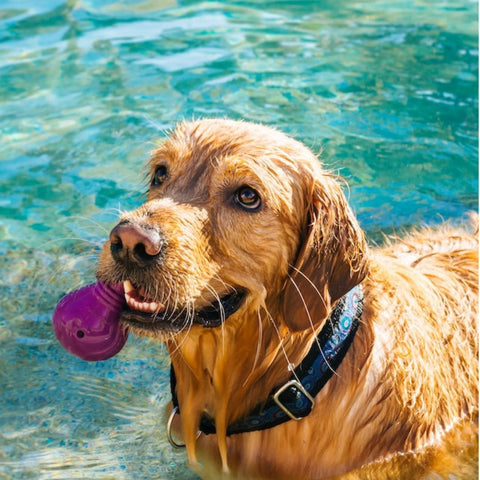
As the summer temperatures rise in Australia, it's not just humans who need to be mindful of the heat - our furry friends are also at risk of suffering from heat stress. Dogs are particularly susceptible to the dangers of overheating, and it's crucial that pet owners understand the signs, symptoms, and prevention strategies to keep their beloved companions safe.
In this comprehensive guide, we will dive into the world of heat stress in dogs, exploring the red flags to watch out for, the potential health risks involved, and most importantly, the proven prevention strategies that can help protect your four-legged friend.
Whether you're a seasoned dog owner or a first-time pet parent, this article will equip you with the knowledge and tools necessary to ensure your canine companion stays cool and comfortable during the dog days of summer. So, let's jump right in and discover how to beat the heat and keep your furry friend healthy and happy!
Understanding Heat Stress in Dogs
Heat stress occurs when a dog's body temperature rises to dangerous levels and exceeds their ability to cool down. Unlike humans, who can regulate their body temperature through sweating, dogs primarily rely on panting to dissipate heat. When the ambient temperature is high, and the air is humid, panting becomes less effective, and dogs can quickly become overheated. Heat stress can escalate rapidly and can lead to more severe conditions such as heat exhaustion and heatstroke.
Heat exhaustion is the initial stage of heat stress and can cause symptoms such as excessive panting, drooling, rapid breathing, and weakness. If left untreated, heat exhaustion can progress to heatstroke, which is a life-threatening condition. Heatstroke symptoms include collapse, seizures, vomiting, diarrhea, and even organ failure. It's vital to recognize the signs of heat stress promptly and take immediate action to prevent the situation from worsening.
Signs and Symptoms of Heat Stress in Dogs in Australia
It's essential to be familiar with the signs and symptoms of heat stress in dogs to ensure early intervention. Some common indicators include excessive panting, drooling, and increased salivation. Dogs may also exhibit signs of distress, such as restlessness, agitation, and seeking cool surfaces to lie on. Other symptoms include rapid breathing, pale gums, weakness, and lethargy.
In more severe cases of heat stress, dogs may experience vomiting, diarrhea, muscle tremors, seizures, and even unconsciousness. It's crucial not to overlook these symptoms, as they can indicate a life-threatening condition. If you suspect your dog is experiencing heat stress, it's vital to take immediate action to prevent further complications.
Factors that Increase the Risk of Heat Stress in Dogs
Several factors can increase a dog's risk of developing heat stress. Understanding these risk factors can help pet owners take proactive steps to prevent heat-related illnesses. Here are some common factors to be aware of:
1. Breed: Certain breeds are more prone to heat stress due to their physical characteristics. Brachycephalic breeds, such as Bulldogs, Pugs, and Boxers, have short muzzles and narrower airways, which can impede their ability to pant effectively and cool down.
2. Age: Puppies and senior dogs have a harder time regulating their body temperature compared to adult dogs. Their immature or declining physiological systems make them more vulnerable to heat stress.
3. Coat: Dogs with thick or long coats can have difficulty dissipating heat, especially in hot and humid environments. It's important to regularly groom these dogs to help keep them cool.
4. Weight: Overweight or obese dogs are at a higher risk of heat stress due to their decreased ability to regulate body temperature. The excess layers of fat can act as insulation, trapping heat and hindering the cooling process.
By being aware of these risk factors, pet owners can take appropriate measures to ensure their dog's well-being in hot weather.
Preventing Heat Stress in Dogs: Importance of Hydration
One of the most crucial aspects of preventing heat stress in dogs is ensuring proper hydration. Dogs lose more water through panting and sweating from their paw pads, making it essential to provide them with constant access to fresh, clean water. Here are some tips to keep your dog well-hydrated:
1. Always have water available: Whether indoors or outdoors, make sure your dog has access to water at all times. Consider placing multiple water bowls in different areas of your home and yard.
2. Carry water on walks: When taking your dog for walks or outings, bring a portable water bottle and a collapsible bowl to provide them with water breaks.
3. Offer water-rich foods: Include water-rich foods in your dog's diet, such as cucumbers, watermelon, and broth-soaked kibble, Man's Best Dog Food is a great choice for adding cool bone broths to for added hydration!
Remember, prevention is key, and prioritising your dog's hydration can go a long way in preventing heat stress.
Preventing Heat Stress in Dogs: Providing Shade and Proper Ventilation
Providing adequate shade and ensuring proper ventilation are essential to help keep your dog cool and comfortable in hot weather. Here's what you can do:
1. Create shaded areas: Set up shaded areas in your yard using umbrellas, tarps, or shade cloth. These areas should provide ample shade throughout the day, especially during the hottest hours.
2. Use cooling mats or pads: Gel cooling mats or pads can provide additional relief from the heat. These products are designed to absorb and dissipate heat, providing a cool surface for your dog to lie on. Add a cooling towel over your dog for maximum benefit.
3. Use fans or air conditioning: If your dog spends time indoors, ensure that the area is well-ventilated with fans or air conditioning. Make sure there's proper airflow to prevent stagnant hot air from accumulating.
By creating a cool and shaded environment, you can significantly reduce the risk of heat stress in your dog.
Preventing Heat Stress in Dogs: Avoiding Excessive Exercise During Hot Weather
Exercise is crucial for a dog's overall well-being, but it's essential to adjust their activity levels during hot weather to prevent heat stress. Here are some guidelines to follow:
1. Choose the right time: Plan your dog's exercise routine during the cooler parts of the day, such as early morning or late evening. Avoid exercising them during peak heat hours.
2. Shorten the duration: Reduce the duration of exercise sessions to prevent overexertion. Keep an eye on your dog's behaviour and signs of fatigue.
3. Provide breaks: During exercise, give your dog frequent breaks in shaded areas and offer them water to keep them hydrated.
Remember, dogs can't regulate their body temperature as efficiently as humans, so it's crucial to be mindful of their exercise routine during hot weather.
Preventing Heat Stress in Dogs: Recognising the Signs and Taking Immediate Action
Despite our best efforts, heat stress can still occur. It's essential to recognize the signs and take immediate action to prevent the condition from worsening. If you notice any of the following symptoms, follow these steps:
1. Move your dog to a cool area: Immediately move your dog to a shaded or air-conditioned area to help them cool down.
2. Offer water: Allow your dog to drink small amounts of water to rehydrate. Do not force them to drink, as it can lead to choking.
3. Use cool water or wet towels: Wet your dog's body with cool water or use wet towels to help lower their body temperature. Focus on areas with high blood vessel concentration, such as the groin, armpits, and paw pads.
4. Contact a veterinarian: If your dog's condition does not improve within a few minutes or if they show signs of severe heatstroke, it's crucial to seek veterinary care immediately.
Remember, quick action can make all the difference in preventing heat-related emergencies.
Cooling Techniques for Dogs with Heat Stress
In addition to the initial steps mentioned earlier, there are several cooling techniques you can use to provide relief to a dog experiencing heat stress:
1. Cool packs: Place cool packs or cold packs wrapped in a towel on your dog's body. This can help lower their body temperature.
2. Misting or spraying with water: Use a spray bottle or misting device to spray cool water on your dog's body. Be cautious not to drench them completely, as wet fur can trap heat.
3. Cooling vests or bandanas: Cooling vests or bandanas are designed to retain water and provide a cooling effect when worn. These can be beneficial in hot weather.
Remember to monitor your dog's condition closely and adjust the cooling techniques accordingly.
Seeking Veterinary Care for Heat-Stressed Dogs
While immediate first-aid measures are crucial, it's essential to seek veterinary care for dogs experiencing heat stress. Heatstroke can cause internal damage, and a veterinarian will be able to assess your dog's condition and provide appropriate treatment. Delaying veterinary care can lead to severe complications and even death. It's always better to err on the side of caution and seek professional help when dealing with heat-stressed dogs.
Ensuring the Well-being of Your Furry Friend
As responsible dog owners, it's our duty to protect our beloved pets from the dangers of heat stress. By understanding the signs, symptoms, and prevention strategies, we can ensure our canine companions stay safe and comfortable during the sweltering summer months. Remember to prioritise hydration, provide shade and proper ventilation, adjust exercise routines, and take immediate action when signs of heat stress arise. With the right knowledge and proactive measures, you can beat the heat and keep your furry friend healthy and happy all year round. So, gear up, stay informed, and enjoy the summer with your four-legged companion by your side!
©deliveryhound.com.au 2023






